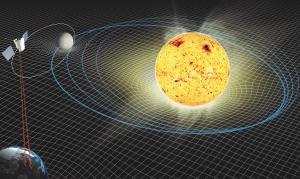Blog
The Incredible
Shrinking Sun
16 April 2018
 NASA’s Goddard Space Flight Center
NASA’s Goddard Space Flight CenterThe Sun’s light is produced by fusion in the Sun’s core. Hydrogen atoms combine to produce helium and light. The light is produced because the mass of a helium atom is slightly smaller than the mass of the four hydrogen atoms that formed it. As Einstein first pointed out, mass and energy can transform into each other, so the loss of mass means a gain of energy in the form of light. The light radiates from the Sun, warming our Earth, but that also means over time the Sun loses mass. The Sun consumes mass to produce light.
As the Sun loses mass its gravitational pull on the planets weakens slightly. The Sun can’t hold the planets as strongly as it used to, so the planets drift a bit further away from the Sun. At least that’s the theory. The shift of the planets is so small that it’s difficult to measure. There have been some studies that seemed to see the effect with Earth, but the result isn’t particularly strong. The usual method of determining planetary distance is to bounce radio signals off them, and it’s difficult to do it precisely enough to determine the Sun’s changing mass.
There is a much better way to measure the position of planets. Simply put a spacecraft in orbit around it. When the Cassini spacecraft was placed in orbit around Saturn, astronomers used radio signals from Cassini to measure the position of Saturn accurate to within a mile. We can do this because we know exactly what signal comes from the spacecraft, so any shift in that signal tells us how the spacecraft moves. When the Messenger spacecraft was placed in orbit, astronomers used the same technique to measure the position of Mercury. Using seven years of data they could also determine how Mercury’s motion changed over time. They did it precisely enough to observe the weakening of the Sun’s gravitational tug.1 They found that the Sun’s pull is weakening by about 0.4 trillionths of a percent per year. That agrees with estimates of the Sun’s mass loss due to core fusion.
Mercury has long been used as a test of Einstein’s theories. It’s motion was the first confirmation that Einstein’s theory of gravity could be correct. It’s only fitting that Mercury has now be used to confirm Einstein’s most famous equation.
Genova, Antonio, et al. “Solar system expansion and strong equivalence principle as seen by the NASA MESSENGER mission.” Nature communications 9.1 (2018): 289. doi:10.1038/s41467-017-02558-1 ↩︎